1993 BUICK LESABRE tow
[x] Cancel search: towPage 265 of 324
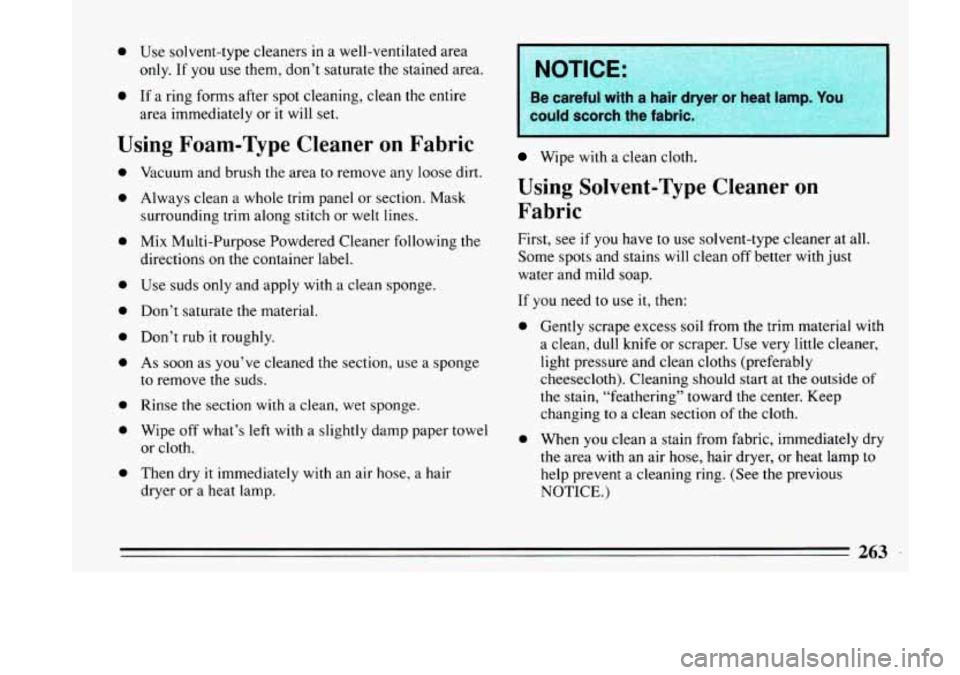
0 Use solvent-type cleaners in a well-ventilated area
only. If you use them, don’t saturate the stained area.
0 If a ring forms after spot cleaning, clean the entire
area immediately or it will set.
Using Foam-Type Cleaner on Fabric
0
0
0
0
0
0
0
0
0
0
Vacuum and brush the area to remove any loose dirt.
Always clean a whole trim panel or section. Mask
surrounding trim along stitch or welt lines.
Mix Multi-Purpose Powdered Cleaner following the
directions on the container label.
Use suds
only and apply with a clean sponge.
Don’t saturate the material.
Don’t rub it roughly.
As soon as you’ve cleaned the section, use a sponge
to remove the suds.
Rinse the section with
a clean, wet sponge.
Wipe off what’s left with a slightly damp paper towel
or cloth.
Then dry
it immediately with an air hose, a hair
dryer
or a heat lamp.
I
Wipe with a clean cloth.
Using Solvent-Type Cleaner on
Fabric
First, see if you have to use solvent-type cleaner at all.
Some spots and stains will clean off better with just
water and mild soap.
If you need
to use it, then:
0
0
Gently scrape excess soil from the trim material with
a clean, dull knife or scraper. Use very little cleaner,
light pressure and clean cloths (preferably
cheesecloth). Cleaning should start
at the outside of
the stain, “feathering” toward the center. Keep
changing to a clean section of the cloth.
When you clean a stain from fabric, immediately dry
the area with an air hose, hair dryer, or heat lamp to
help prevent a cleaning ring. (See the previous
NOTICE.)
263
Page 268 of 324
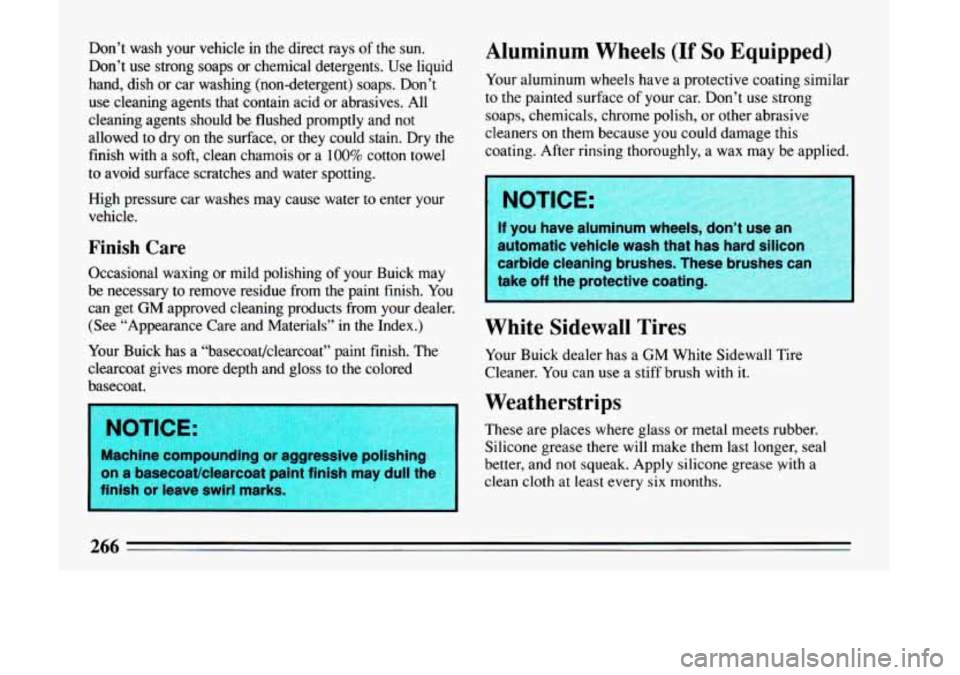
Don’t wash your vehicle in the direct rays of the sun.
Don’t use strong soaps or chemical detergents. Use liquid
hand, dish or car washing (non-detergent) soaps. Don’t
use cleaning agents that contain acid or abrasives. All
cleaning agents should
be flushed promptly and not
allowed to dry on the surface, or they could stain. Dry the
finish with a soft, clean chamois or a 100% cotton towel
to avoid surface scratches and water spotting.
High pressure car washes may cause water to enter your
vehicle.
Finish Care
Occasional waxing or mild polishing of your Buick may
be necessary
to remove residue from the paint finish. You
can get
GM approved cleaning products from your dealer.
(See “Appearance Care and Materials”
in the Index.)
Your Buick has a “basecoat/clearcoat” paint finish. The
clearcoat gives more depth and gloss to the colored
basecoat.
finish or leave swirl marks,
Aluminum Wheels (If So Equipped)
Your aluminum wheels have a protective coating similar
to the painted surface of your car. Don’t use strong
soaps, chemicals, chrome polish, or other abrasive
cleaners on them because
you could damage this
coating. After rinsing thoroughly, a wax may be applied.
If you have aluminum wheels, don’
automatic vehicle wash that has hard silico
carbide cleaning brushes. TheFm brushes can
White Sidewall Tires
Your Buick dealer has a GM White Sidewall Tire
Cleaner. You can use a stiff brush with
it.
Weatherstrips
These are places where glass or metal meets rubber.
Silicone grease there will make them last longer, seal
better, and not squeak. Apply silicone grease with a
clean cloth at least every six months.
Page 272 of 324
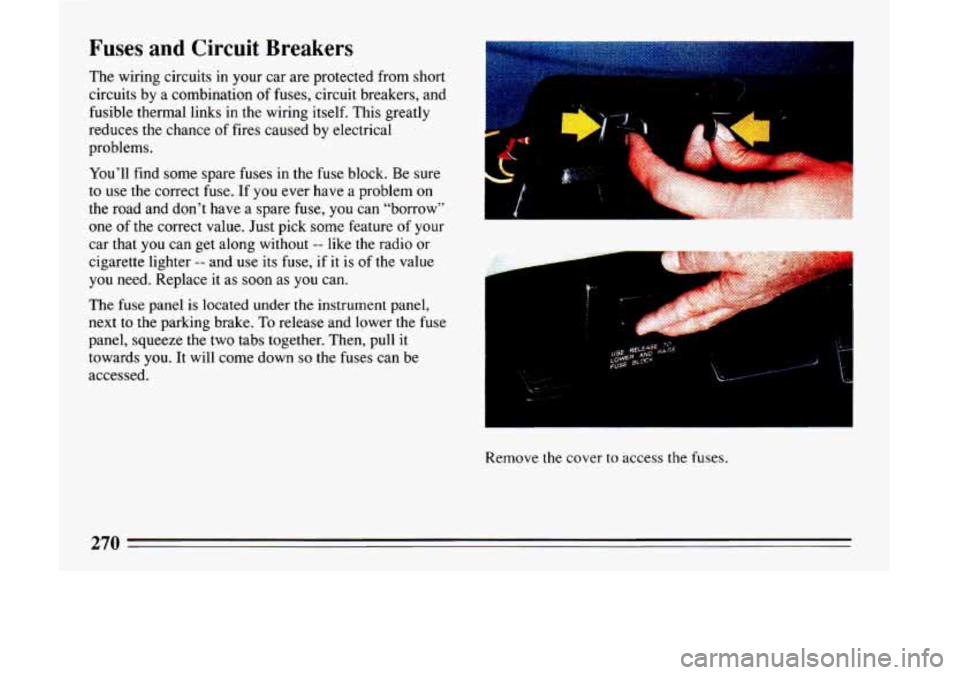
Fuses and Circuit Breakers
The wiring circuits in your car are protected from short
circuits by a combination
of fuses, circuit breakers, and
fusible thermal links
in the wiring itself. This greatly
reduces the chance
of fires caused by electrical
problems.
You’ll find some spare
fuses in the fuse block. Be sure
to use the correct fuse.
If you ever have a problem on
the road and don’t have a spare fuse,
you can “borrow”
one
of the correct value. Just pick some feature of your
car that
you can get along without -- like the radio or
cigarette lighter
-- and use its fuse, if it is of the value
you need. Replace it as soon as you can.
The fuse panel
is located under the instrument panel,
next to the parking brake.
To release and lower the fuse
panel, squeeze the two tabs together. Then, pull it
towards you.
It will come down so the fuses can be
accessed.
c m
k
Remove the cover to access the fuses.
270
Page 283 of 324
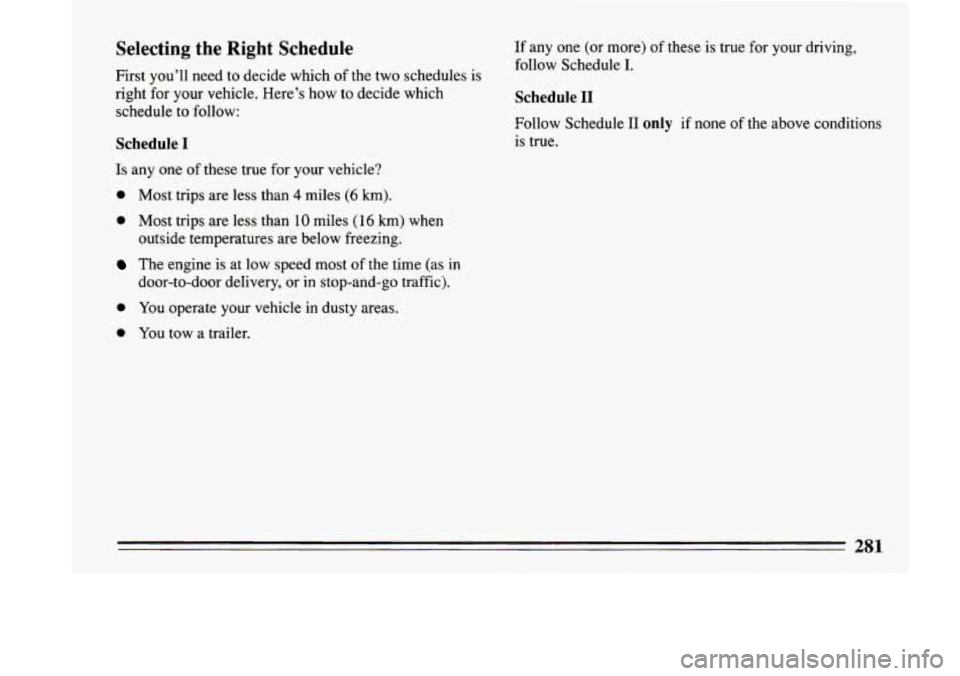
Selecting the Right Schedule
First you’ll need to decide which of the two schedules is
right for your vehicle. Here’s how to decide which
schedule to follow:
Schedule I
Is any one of these true for your vehicle?
0 Most trips are less than 4 miles (6 km).
0 Most trips are less than 10 miles ( 16 km) when
outside temperatures are below freezing.
The engine is at low speed most of the time (as in
door-to-door delivery, or in stop-and-go traffic).
0 You operate your vehicle in dusty areas.
0 You tow a trailer. If any
one
(or more) of these is true for your driving,
follow Schedule I.
Schedule I1
Follow Schedule I1 only if none of the above conditions
is true.
281
~ __.- ..
Page 284 of 324
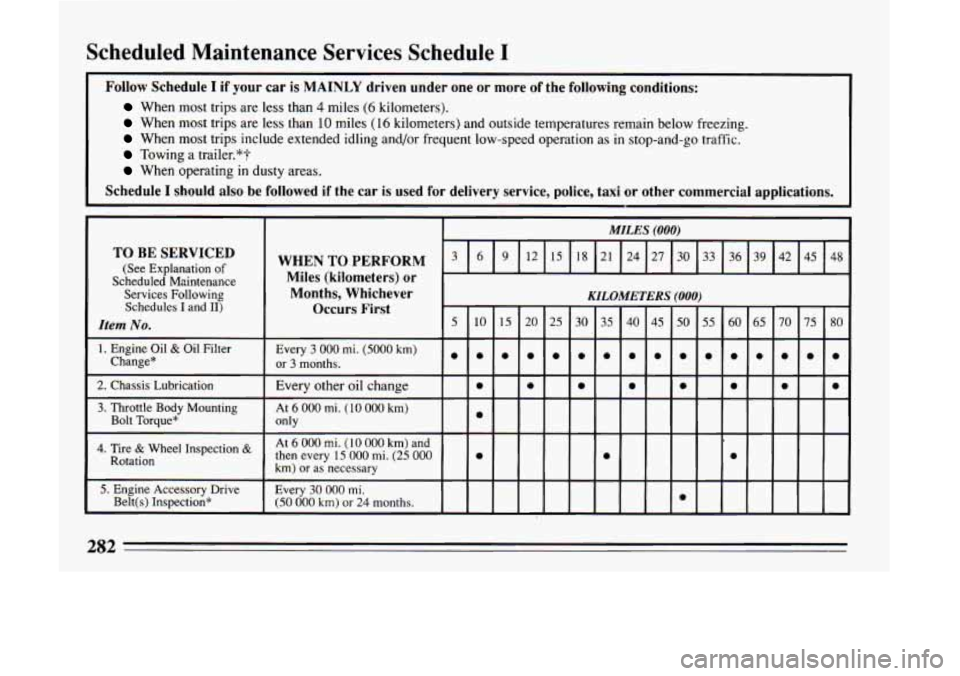
Scheduled Maintenance Services Schedule I
Follow Schedule I if your car is MAINLY driven under one .or more of the following conditions:
When most trips are less than 4 miles (6 kilometers).
When most trips are less than 10 miles (16 kilometers) and outside temperatures remain below freezing.
When most trips include extended idling and/or frequent low-speed operation as in stop-and-go traffic.
Towing a trailer.*?
When operating in dusty areas.
Schedule I should also be followed if the car is used for delivery service, police, taxi or other commercial applications.
I I MILES (000) ~ ~ ~~
TO BE SERVICED
Miles (kilometers) or
Scheduled Mzintenance
48 45 42 39
36
33 30 27
24 21 18 15 12 9 6 3 WHEN TO PERFORM (See Explanation of
~ ~~ ~~
Services Following
Schedules I and
11)
Months, Whichever
Occurs First
Item No.
1. Engine Oil & Oil Filter Every 3 000 mi. (5000 km)
Change* or
3 months.
2. Chassis Lubrication Every
other oil change
3. Throttle Body Mounting At 6 000 mi. (10 000 km)
~~
Bolt Torque*
only
4* Tire & Inspection & then every 15 000 mi. (25 000 At 6 000 mi. ( 10 000 km) and
km)
or as necessary
Rotation
5. Engine
Accessory Drive
Every 30 000 mi.
Belt(s) Inspection* (50 000 km) or 24 months.
5 10
e.
e
e
e
20 25
e.
e
KILOMETERS (000)
30 35
me
e
e
40 45
em
e
50 55
me
e
e
282
Page 289 of 324

Inspect hoses and replace if they are cracked,
swollen or deteriorated. Tighten screw-type hose
clamps. Clean the outside
of the radiator and air
conditioning condenser. Wash the pressure cap and
neck.
8.
To help ensure proper operation, we recommend a
pressure test of both the cooling system and the
pressure cap.
7. Transaxle Service -- Change both the fluid and
filter every
15,000 miles (25 000 km) if the vehicle
is mainly driven under one or more of these
conditions:
0 In heavy city traffic where the outside
temperature regularly reaches
90 F (32 C) or
higher.
0 In hilly or mountainous terrain.
0 When doing frequent trailer towing.
0 Uses such as found in taxi, police car or delivery
service.
9.
If you do not use your vehicle under any of these
conditions, change both the fluid and filter every
100,000 miles
(140 000 km).
Spark Plug Replacement* -- Replace spark plugs
with the proper type. See "Specifications Chart" in
the Index.
Spark Plug Wire Inspection*? -- Inspect for
burns, cracks or other damage. Check the boot fit at
the distributor and at the spark plugs. Replace wires
as needed.
10. Air Cleaner Filter Replacement* -- Replace every
30,000 miles (50 000 km) or more often under dusty
conditions. Ask your dealer for the proper
replacement intervals for your driving conditions.
11. Fuel Tank, Cap and Lines Inspection"? -- Inspect
fuel tank, cap and lines (including fuel rails and
injection assembly,
if equipped) for damage or leaks.
Inspect fuel cap gasket for an even filler neck
imprint or any damage. Replace parts as needed.
Periodic replacement
of the fuel filter is not required.
* An Emission Control Service.
-t The U.S. Environmental Protection Agency has determined that the failure to perform this maintenance item will not nullify the emission warranty or limit recall liability prior to the completion of vehicle
useful life. General Motors, however, urges that all recommended maintenance services be perlormed at the indicated intervals and the maintenance be recorded in "Section E:Maintenance Record".
287
Page 307 of 324
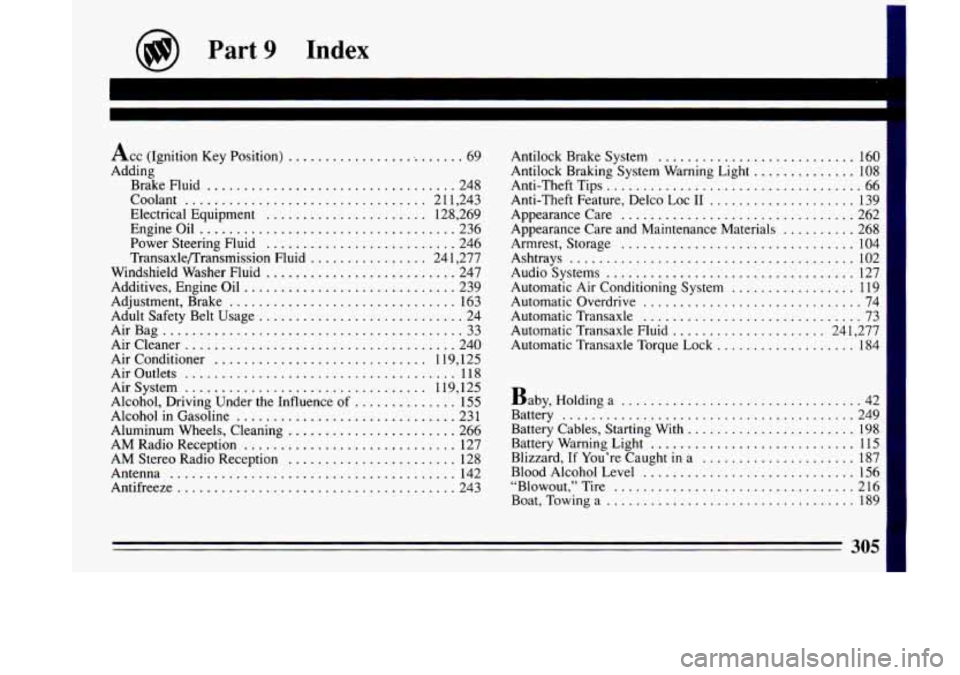
XI Engineoil ..................................
Power Steering Fluid .........................
Transaxle/Transmission Fluid ................ 24
Windshield Washer Fluid
.........................
Additives . Engine Oil ............................
Acc (Ignition Key Position) ......................... 69
Adding Brake Fluid
.................................. 248
Coolant
................................. 211. 243
Electrical Eauiument
...................... 128. 269
. 236
. 246
1. 277
. 247
I” . 239
Adjustment. Brake
............................... 163
Adult Safety Belt Usage
............................ 24
AirBag
......................................... 33
Aircleaner ..................................... 240
Air Conditioner
............................. 1 19. 125
Air Outlets
..................................... 11 8
Air System
................................. 1 19. 125
Alcohol. Driving Under the Influence
of .............. 155
Alcohol in Gasoline .............................. 231
Aluminum Wheels. Cleaning
....................... 266
AM Radio Reception
............................. 127
AM Stereo Radio Reception
....................... 128
Antenna
....................................... 142
Antifreeze
...................................... 243
@) Part 9 Index
Antilock Brake System ........................... 160
Anti-Theft Tips
................................... 66
Anti-Theft Feature. Delco Loc I1 .................... 139
Appearance Care
................................ 262
Armrest. Storage
................................ 104
Ashtrays ....................................... 102
Audio Systems
.................................. 127
Automatic Air Conditioning System
................. 119
Automatic Overdrive
.............................. 74
Automatic Transaxle
.............................. 73
Automatic Transaxle Fluid
..................... 24 1. 277
Automatic Transaxle Torque
Lock ................... 184
Antilock Braking System Warning Light
.............. 108
Appearance Care and Maintenance Materials .......... 268
Baby. Holding
a ................................. 42
Battery
........................................ 249
Battery Cables. Starting With
....................... 198
Battery Warning Light
............................ 115
Blizzard.
If You’re Caught in a ..................... 187
BloodAlcoholLevel
............................. 156
“Blowout. .. Tire ................................. 216
Boat. Towinga .................................. 189
305
Page 308 of 324

Brake Adjustment
................................... 163
Fluid 248 .......................................
Lining Replacement. How to Drive After .......... 249
Master Cylinder
.............................. 248
Brake-Transaxle Shift Interlock
................... 73. 80
Brake System. Antilock Warning Light ............... 108
Brake System Warning Light
....................... 107
Brake Wear Indicators. Disc
....................... 162
Brakes. Antilock
................................ 160
Braking Emergencies
............................. 163
Braking if Your Engine Stops
...................... 160
Break-In. New Vehicle
............................. 68
Break-In Schedule. When Towing a Trailer
............ 189
Bulb Replacement. Headlamp
...................... 250
Bulb Replacement Taillamp
........................ 252
Bulbs. Halogen
.................................. 250
Bulbs.
Turn Signal ................................ 85
Parking ...................................... 76
PedalTravel
................................. 163
Brakes,Rear
.................................... 163
Braking 158 ........................................
Bulbchart ..................................... 274
Camper. Towing a
.............................. 189
...................................... Capacities 275
Cap. Radiator Pressure 245
Care,Appearance
................................ 262
I ............................ Carbon Monoxide in Exhaust ....................... 81
Cassette Tape Player Care
......................... 141
Cautions, Safety
.................................. 10
CB Radio, Adding a
.............................. 128
I
Cellular Telephone. Adding a ...................... 128
“Change Oil Soon” Light
.......................... 114
Change Oil. When to
............................. *239
Changing a Flat Tire
.............................. 216
Charge.Battery.. Warning Light
..................... 115 .
“Check Oil Level” Light .......................... 113
Engine Coolant
............................... 243
Engine Oil Level
.............................. 236
Power Steering Fluid
.......................... 246
Safety Belt Systems
............................ 55
Transaxle Fluid ............................... 241
Windshield Washer Fluid
.......................... 247
Chemical Paint Spotting
........................... 367
Children and Safety Belts
.......................... 41
Cleaner. Air
............... .................... 240
Aluminum Wheels
............................ 266
Inside Your Car
................................ 262
Outside Your Car
............................. 265
Top of the Instrument Panel ..................... 264
Underbody
of Your Car ........................ 267
Vinyl
or Leather .............................. 264
..................................... Chains. Tie 261
Checking BrakeFluid
.................................. 248
UndertheHood
................................. 234
.................................. Child Restraints 43
Cigarette Lighter
................................ 103
CircuitBreakers
................................. 270
City Driving 175
Cleaning ....................................
Fabric ...................................... 263
Glass
...................................... 265
PowerAntenna
............................... 142
Safety Belts 265 ..................................